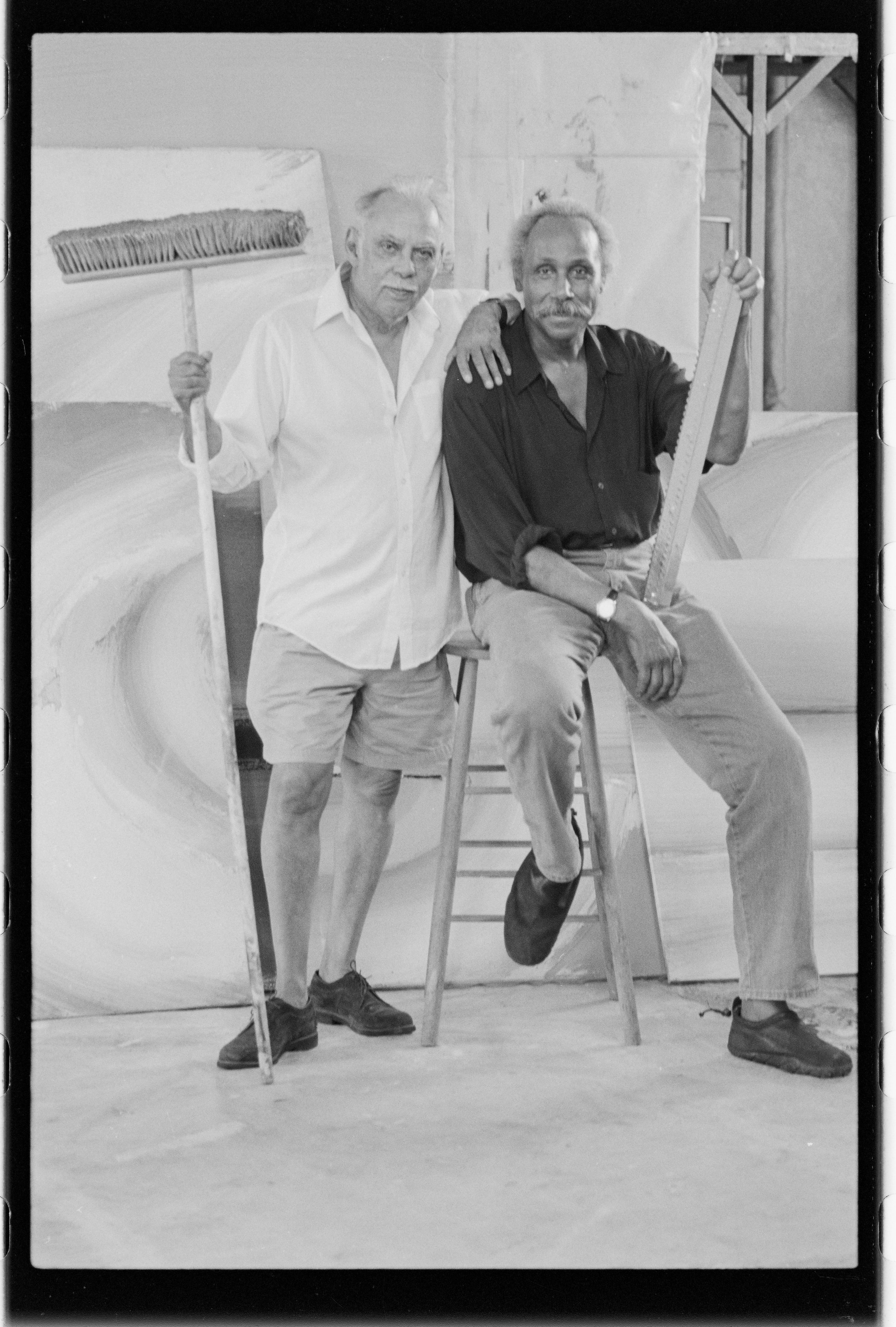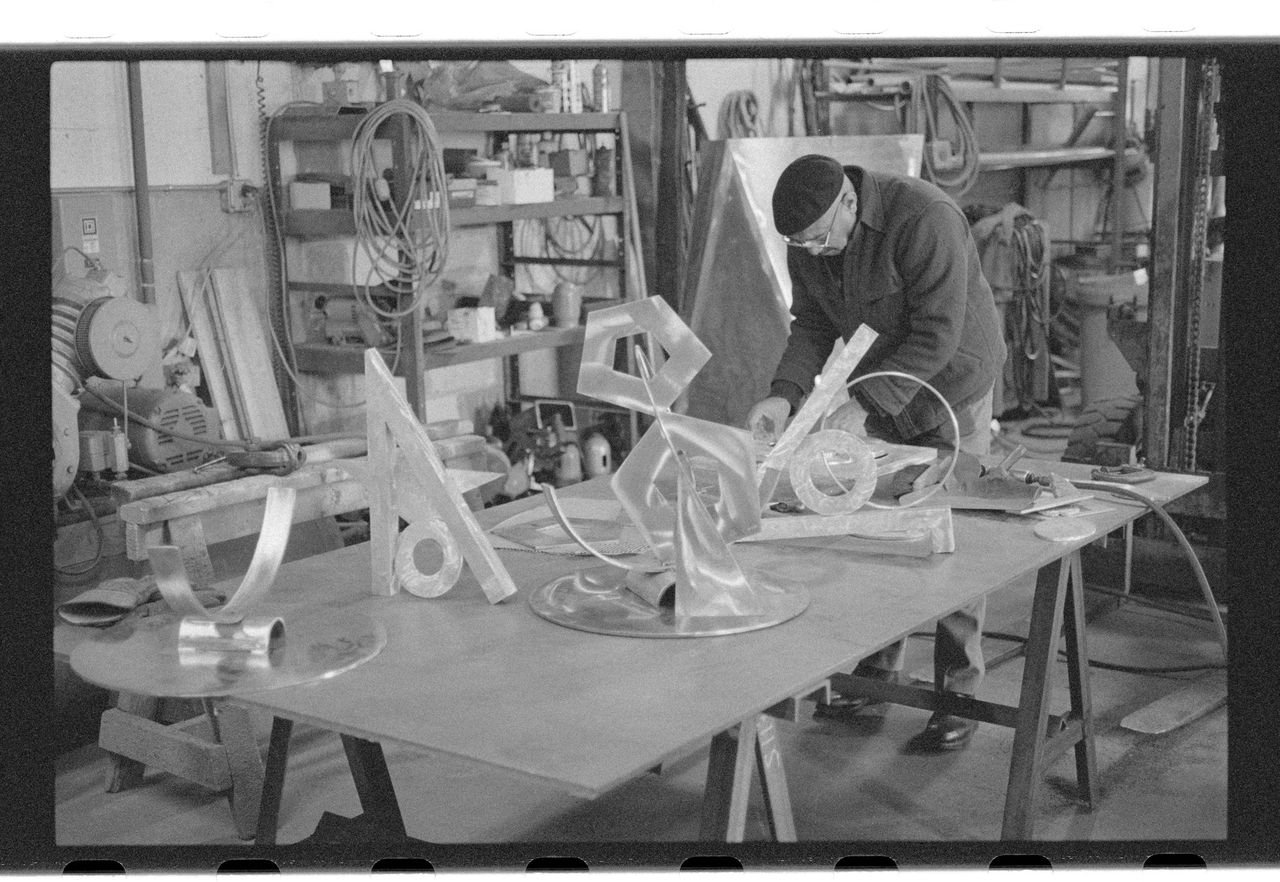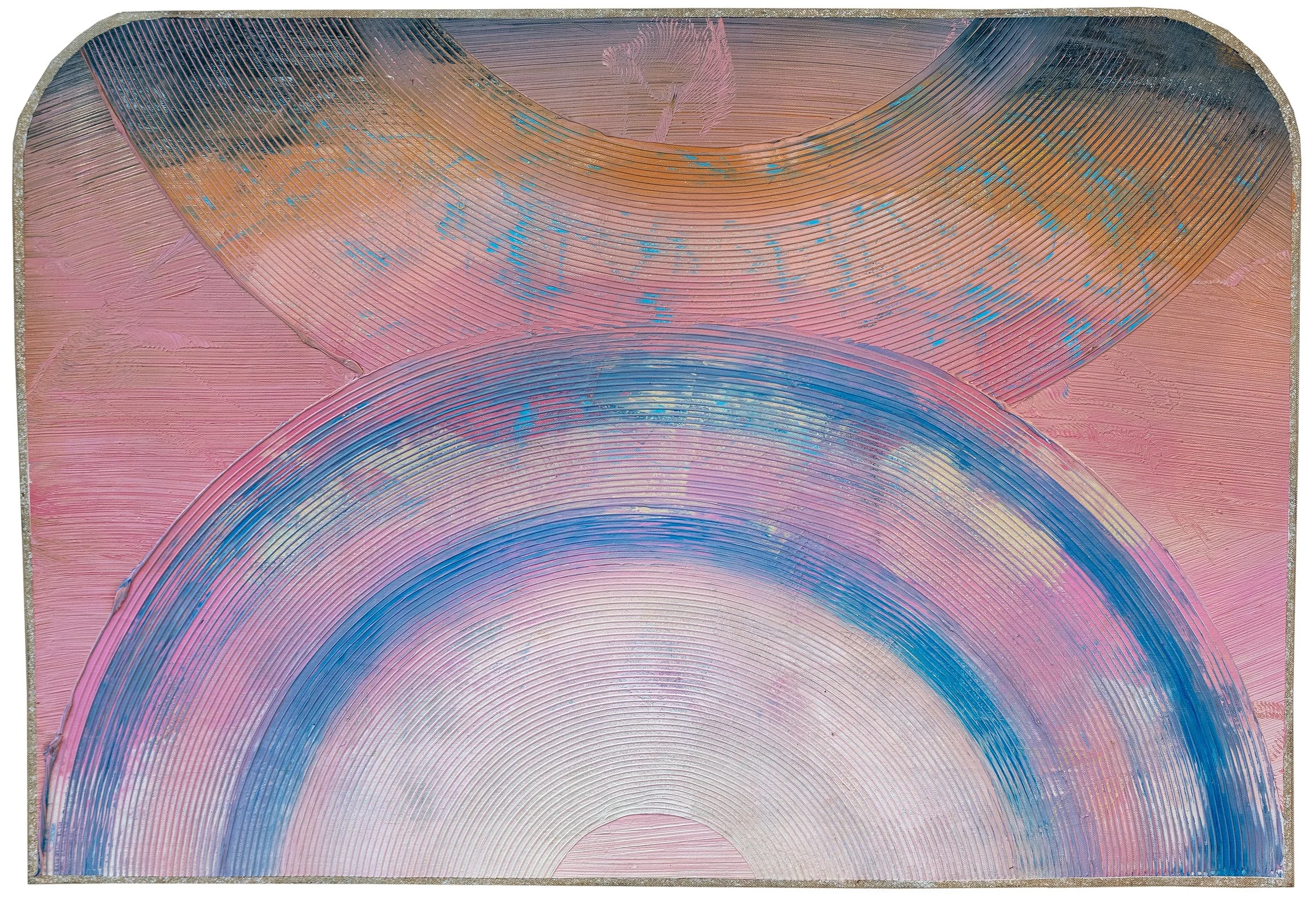
The Method
“[It was]...in the early 1960s that Cowans began his painting practice, driven by a desire to work with his hands.”
Golden Future, 1969; acrylic on black fabric, 55 x 56 inches
While familiar to most as a photographer,
Cowans extensive portfolio demonstrates the difficulty of classifying his painting and photography practices within any particular movement, as they span the boundaries of various genres. In Cowans’ eyes, there is "no difference between photography and painting..[it’s] about your communication with form.” (1)
In the late 1960s, Cowans met “Danny” (Daniel LaRue) Johnson through a mutual friend, musician Ornette Coleman, whose band would rehearse outside of Coleman’s and Johnson’s respective buildings in SoHo. Johnson and Cowans grew to be lifelong friends and were both integrated in a network of fellow Black abstract painters based downtown. Living at 136 West Broadway, Cowans was located less than six blocks from several of the 5 + 1 artists, including Melvin Edwards, Johnson, Jack Whitten and William T. Williams, and recalls they frequently visited one another. Cowans studio was a particularly popular spot, as he noted, “everybody came by my studio because I was a photographer.” While seen primarily as a photographer by many of his contemporaries, conversations around abstraction and painting were central to his close friendships with painters Johnson, Peter Bradley, and Ed Clark.
The original 5 + 1 exhibition took place from October 16 to November 8, 1969 at the State University of New York at Stony Brook. The original exhibiting artists were Daniel LaRue Johnson, Melvin Edwards, Al Loving, William T. Williams, Jack Whitten, and Frank Bowling (the “+1”). Adger went along at Johnson’s suggestion to Stony Brook to document the event in photos. In the more recent, Revisiting 5 + 1, he was added to roster of exhibiting artists, along with Alma Thomas, Vivian Browne, Mary Lovelace O’Neal, Howardena Pindell, Betye Saar, and Mildred Thompson.

Adger and Ed Clark

Jack Whitten

Romare Bearden, Adger, Norman Lewis, and Ernest Crichlow

Adger & Friends at Ann Black Gallery

Adger and Peter Bradley

Daniel LaRue Johnson

Al Loving
Excerpts from a conversation between Adger Cowans, Steve Albahari (21st Editions), and Thom Pegg (Black Art Auction)
Untitled, 1973; acrylic with gold powder on canvas, 22-3/4 x 20-1/4 inches
ALL IMAGES OF ARTWORK AND PHOTOGRAPHS TAKEN BY ADGER COWANS ARE THE PROPERTY OF ADGER COWANS AND ALL RIGHTS RESERVED. THEY MAY NOT BE USED IN ANY WAY WITHOUT EXPRESSED WRITTEN CONSENT.
Adger points to a few works on the wall,
“Those were the earliest combed pieces I did before anyone else was doing it. I had no money, was poor as a jaybird, eating saltine crackers. Everybody told me, “that’s not art.” They couldn’t figure out what I had done. I found a little German comb on Canal Street , so [with] the first ones, the grooves were more narrow. I knew about this Western store—I bought my Levis there—they had all of this cowboy stuff and they had these horse combs. They used them to groom the horses and at that time they were rounded on the ends. I bought a bunch of them. It is very difficult to make those circular lines with a trowel. I wanted something that was flowing, so I put one [comb] on each end.
Then I found this gold powder made from mica that does not fade. That (pointing to a painting) was made in 1970 and the gold is still good. At first I used real gold powder and it turned black; but once I found this I was cool.
Adger: I cut sheet metal with round holes in it with a hacksaw and started using that to comb also. It was laborious.
The group’s looking at an image of Ed Clark holding a broom and Adger holding a large comb, and Adger says:
That show was at Danny Simmons’ place.” Adger is referring to an exhibition of works by he and Ed Clark, called Sweeps & Views, held at the Rush Arts Gallery, 526 West 26th Street, New York, NY (September 26, 1998-October 27, 1998). Rush Arts is owned by Danny Simmons.
Ed [Clark] had a studio on 22nd street—I could work big there. When he went to France in the summer, I would work there.
The sfumage works were also done at Ed’s studio. I put the smoke over color. I used those long candles they use at the Catholic Church and put this paper thing over my hand… Then I went to Suriname and they have these little lamps with cotton in them and I started using those because the color was blacker.
Albahari to Pegg: Does that matter to your audience? The process? Or is it just the end result?
Pegg: It doesn’t necessarily make it better or lesser; it’s certainly interesting and people are curious about how it happens…because they can’t do it, so they want to know how he [Adger] can.
Adger:
Jack Whitten came down to my studio and said, “I came down to see you, Cowans”. He never called me Adger…he always called me Cowans. He walked into my studio and saw I had all these combs and stuff. The next day I walked up to his studio and knocked on his door (Adger makes a knocking sound on the table). Whitten said, “I can’t let you in Cowans—Im working!”. I went in and he said, “I’m not doing what you’re doing! I’m raking!”. He [Whitten] had never seen anything like that before—he was painting like Jackson Pollock then. If you see the style he was painting in at the show at Stony Brook [Adger is referring to the exhibition in 1969 at the State University of New York at Stony Brook, 5 + 1 ]. He saw what I was doing and thought he would change his whole thing. Then Sam Gilliam took it from him. Painters stole shit left and right.
Double, 1975; acrylic on canvas, 29-1/4 x 42 inches (image)
“What I consider spiritual is the fact that I can connect to that invisible part of me, that inner voice. I don't have anything to do with where that comes from. I can only feel it. It's like when you create a work of art, you get out of the way and allow the work to happen.”
— Interview with Carrie Mae Weems, Bomb, July 30, 2014
Excerpts from a conversation between Adger Cowans, Steve Albahari (21st Editions), and Thom Pegg (Black Art Auction)
Adger speaking about aligning dates with styles in his work:
I want people to look at this and say, this is NOW—it doesn’t matter when I did it.
Spirit is now and forever. I am categorically against protest art—and maybe I shouldn’t be because I am a Black man—but I am. I have met people who were racists and they wanted to fuck me around. They are all the same and they have a weakness—they do not know their humanity, and it opens them up for a big fall. They relate to something that doesn’t exist, something imaginary—they don’t relate to their humanity, and that’s all there is.
Because I wasn’t trained as a painter, I wanted to use paint as a subject. I stopped using brushes. All my work is about discovery.
You must be a brave person to fuck with a blank canvas, because you have to come up with something and 9 times out of 10 you don’t come up with shit.




